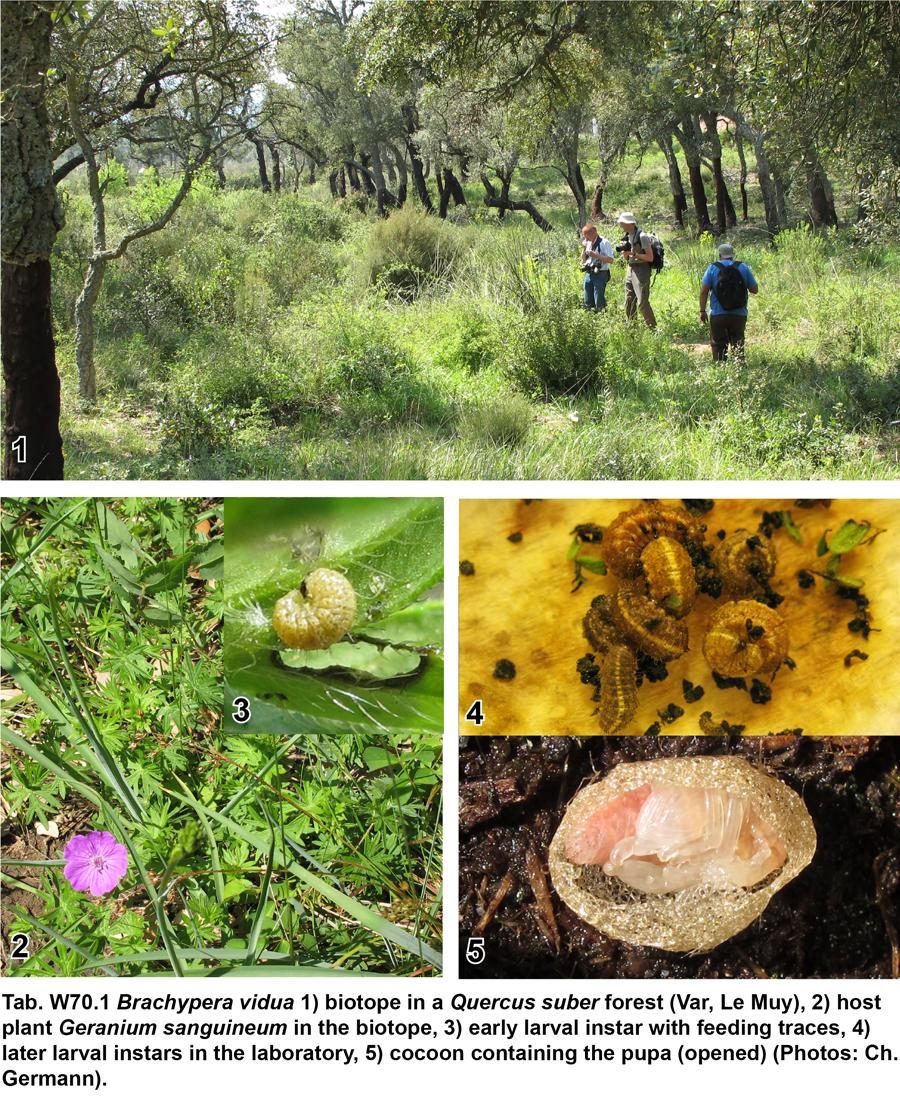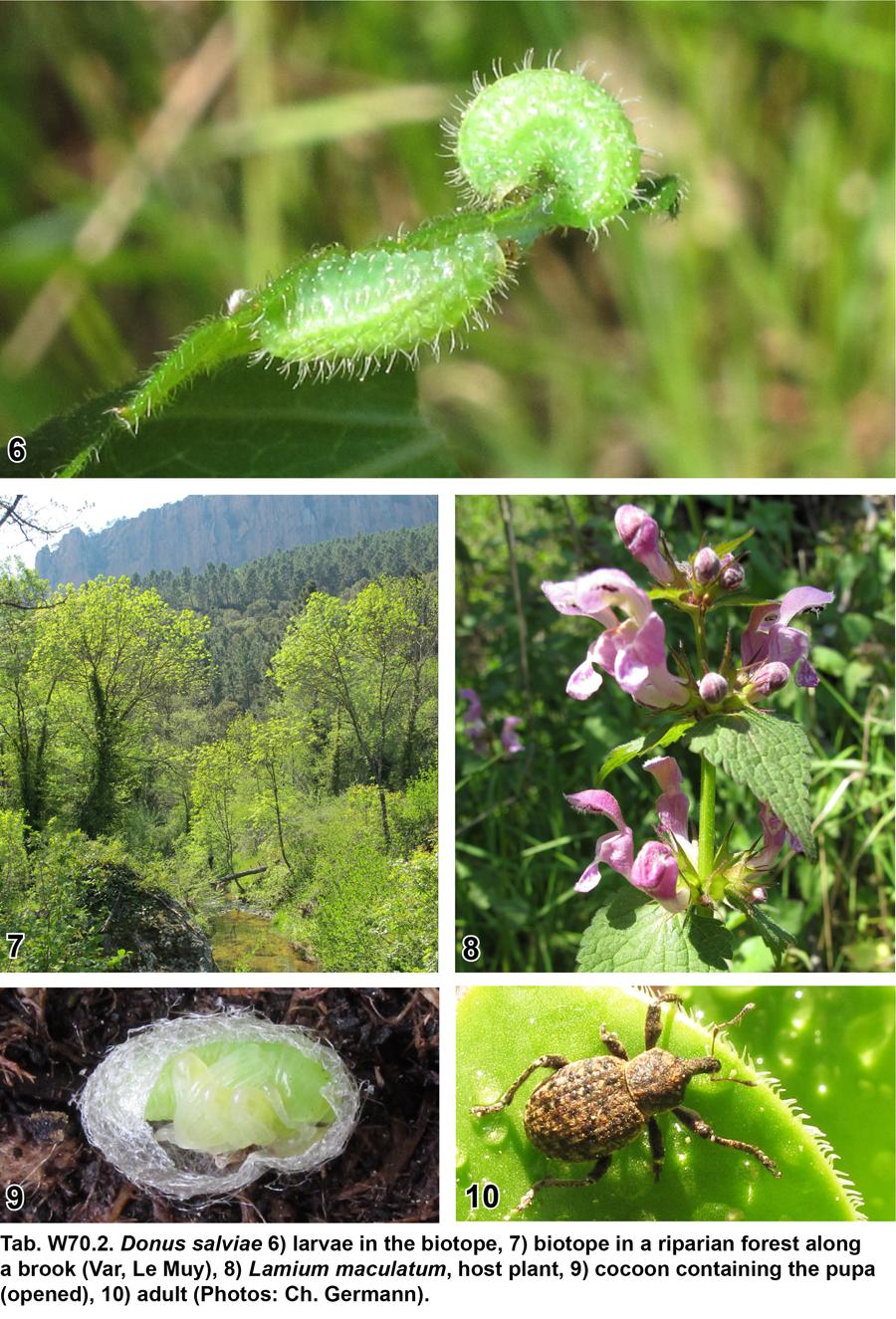



Observations on the biology of Brachypera vidua (Gené, 1837), Donus salviae (Schrank, 1789), and Hypera melancholica (Fabricius, 1793) are reported and illustrated. All species were collected in their larval instars and reared to the adult stage. Several new host plants and feeding plants are reported.
Hyperini, Brachypera vidua, Donus salviae, Hypera melancholica, biology, host plants, France, Var
In springtime, species of Hyperini are comparably easy to collect in their larval instars on their respective host plants, as larval development is ectophagous. Some species are even easier to collect in their preimaginal stages compared to the adults, as those show a hidden lifestyle including nocturnal activity or an aestivation in summer.
Records of host plants of Hyperini are far from being complete, and literature references are partly doubtful. This because not all species have been reared on their potential host plants, and host plants (where larval development takes place) and feeding plants (where adults feed on) have not been properly discriminated. However, recent research by [Skuhrovec 2003], [Skuhrovec 2005a and 2005b], [Skuhrovec 2006], [Skuhrovec 2007], [Skuhrovec 2009], and the [Curculio Team East 2010] compiled data on biology, and contributed substantially to the knowledge of the morphology of the preimaginal stages.
During an excursion to southern France from 16 to 24 April 2011, observations on weevils (Curculionoidea) were made. Those concerning Hyperini are reported herein.
Breeding experiments were carried out under environmental temperature conditions at the author’s home city (Thun) in a plastic terrarium with sandy ground, where larvae and pupae where kept in plastic boxes (diameter: 50 mm, height: 20 mm) with absorbent paper on the ground, together with their feeding plants. These were exchanged every second to third day.
Feeding experiments with adults were performed under the same conditions as reported above. The served leaves were always offered together with leaves of the host plants where the larval instars were originally found feeding in the biotope. Positive feeding was only counted, if half of the surface of the served leaves of the size 15 x 15 mm was consumed.
Adult specimens were dry-mounted and are conserved in the author’s collection. Some adult specimens and larval instars were conserved in 90% alcohol for future studies.
31 larvae were collected (19 at Le Muy and 12 larvae in the Gorges du Blavet). Dozens more were observed. Larvae were collected in at least three different instars. All larvae were collected from Geranium sanguineum L., where they fed on flower buds and surrounding leaves.
at two localities: Var, northeastern from Le Muy, N43°30’48” / E6°37’20”, 80 m a.s.l., and eastern from Le Muy, in the Gorges du Blavet, N43°31’40” / E6°39’17”, 196 m a.s.l. Both sites were visited on 21 April 2011.
At le Muy in a Quercus suber forest along a brook; in the Gorges du Blavet in a mixed forest (Pinus, Quercus spp.), and a brook nearby.
one larva died. Pupation started at the beginning of May. Till 20 May all pupated, some even without a cocoon. The first adults hatched from 25 May on. Not a single larva had been parasitized. This observation was also made by [Strejcek & Dieckmann 1987] during their breeding experiments, although a single parasitoid (most probably an Ichneumonidae) was shown among eight collected larvae by [Germann 2011].
the presently reported habitats differ considerably from the xerothermic biotope on chalkstone, where Brachypera vidua lives e.g. in Switzerland [Germann 2011]. An often-observed niche shift by the plant (and the weevil) towards more shaded conditions in southern regions might explain this.
The numerous finds of larvae at both locations show that Brachypera vidua has to be very common there. This is contradicted by the indication of [Hoffmann 1954], where he considers Brachypera vidua as a very rare species in France. The nocturnal activity of the adults might be – perhaps generally – the reason for a steady underestimation of the species’ commonness. In a feeding test with the adults also Geranium dissectum L., G. molle L., G. robertianum L. s.l. and G. sylvaticum L. were consumed (together with simultaneously provided Geranium sanguineum). Even the often cultivated Pelargonium zonale (L.) from South Africa was fed (!). Other host plants than G. sanguineum were already reported by [Strejcek & Dieckmann 1987] in laboratory rearing with Geranium molle and G. palustre L. However, I do not know of any reported larval finds in situ (in the biotope) on other Geranium spp. than G. sanguineum. It has to be stated that laboratory conditions usually reveal much more feeding plants than field conditions, perhaps except in extremely monophagous species.
13 larvae, all observed larvae were collected. Larvae were found mainly under the leaves of Lamium maculatum L. and Origanum vulgare L.
Var, eastern from Le Muy, in the Gorges du Blavet, N43°31’40” / E6°39’17”, 196 m a.s.l., visited on 21 April 2011.
in a riparian forest (Alnus, Acer spp.) along a brook.
one larva died, another was conserved in 80 % alcohol. Next 11 larvae pupated till 8 May. Three adults hatched till 15 May, the remaining 8 were parasitized by Ichneumonidae, Hymenoptera (which will overwinter, and are hence not yet determined). Those endoparasitoids are generally well studied as they are used as biological control agents against Hypera postica (Gyllenhal, 1813), see e.g. [Bartell & Pass 1978].
two new host plants Lamium maculatum and Origanum vulgare are presented here. Furthermore feeding experiments of the adults were performed with various leaves of the following plant species: Apiaceae (Anthriscus sp., Foeniculum vulgare (L.) Mill., Levisticum officinale W. D. J. Koch), Asteraceae (Achillea millefolium L., Erigeron annuus (L.) Pers., Taraxacum officinale sect. Ruderalia), Geraniaceae (Geranium sanguineum), Lamiaceae (Salvia pratensis L., Melissa officinalis L., Mentha sp.), Polygonaceae (Rumex sp.), Rosaceae (Fragaria vesca L., Geum rivale L., Potentilla reptans L., Sanguisorba minor Scop.). Up to date Mentha pulegium L. was reported by [Hoffmann 1954] as a host plant for Donus salviae. Interestingly, the same author reported on hatched adults from the region Provence only in early to late July, which is much later compared with the present observations (middle of May), and those by [Venturini 1973] from the first decade of May. A further host plant was reported by this latter author, [Venturini 1973], with Fragaria vesca (Rosaceae). Thereby cultivated plants were attacked in Italy (Tavazzano, Milano) by Donus salviae. [Colonnelli & Osella 1998] considered Donus salviae living oligophagous on Lamiaceae, and [Abbazzi & Maggini 2009] reported generally Mentha spp. Further observations were reported by the [Curculio Team East 2010] with Thymus, and adults on Carduus sp. (Asteraceae) and Rumex crispus L. (Polygonaceae). Summarizing, the present overview strongly suggests that Donus salviae is a polyphagous species that feeds and develops on a rather broad spectrum of host plants.
5 larvae were collected on Vicia villosa Roth s.l.
Var, eastern from Le Muy, in the Gorges du Blavet, N43°31’40” / E6°39’17”, 196 m a.s.l., visited on 21st of April 2011.
at dry and sandy places close to a riparian forest (Alnus, Acer, Carpinus spp.) along a brook.
larvae pupated towards the end of April. The adults hatched around 10 May.
the host plant Vicia villosa is reported for the first time. Own observations on 17 April 2006 on the same host plant at similar dry and sandy places around the Etang de Biguglia on Corsica island (Germann, unpublished) already showed that Hypera melancholica lives on this plant. Actually surprisingly little is known on the host plants of the species in its natural habitat. [Hoffmann 1954] indicated that records are doubtful because of determination difficulties (confusion with Hypera postica), and indicated Medicago sativa L., M. falcata (L.) Arcang. and Trifolium pratense L. as feeding plants of the adults. [Scherf 1964] added Melilotus, and [Skuhrovec 2003], [Skuhrovec 2005], [Skuhrovec 2009] added furthermore Anthyllis (vulneraria L.), Trigonella and Vicia. [Bayer & Winkelmann 2005] indicated generally that Hypera melancholica lives oligophagous on Fabaceae.
I am thankful to Heiner Ziegler (Chur) for organizing the excursion. I thank all members of the Entomologischer Verein Bern joining the excursion for the pleasant and constructive atmosphere, namely Martin Albrecht, Markus Fluri, Bernhard Jost, Thomas Kissling, Peter Sonderegger, Hanspeter, Sabine and Sebastian Wymann. I am thankful to Peter Sprick (Hannover) and to Jiri Skuhrovec (Prague) for their helpful comments on an earlier draft of the manuscript. Thanks to Elsa Obrecht (Natural History Museum Bern) for checking the English.
Abbazzi P. & Maggini L. (2009): Elenco sistematico-faunistico dei Curculionoidea italiani, Scolytidae e Platypodidae esclusi (Insecta, Coleoptera). - Aldrovandia 5: 29-216.
Bartell D.P. & Pass B.C. (1978): Effects of Bathyplectes curculionis and Bathyplectes anurus (Hym.: Ichneumonidae) on the growth and development of Hypera postica (Col.: Curculionidae). - Entomophaga 23 (3): 281-291.
Bayer C. & Winkelmann H. (2005): Rote Liste und Gesamtartenliste der Rüsselkäfer (Curculionoidea) von Berlin. - In: Der Landesbeauftragte für Naturschutz und Landschaftspflege / Senatsverwaltung für Stadtentwicklung. - Rote Listen der gefährdeten Pflanzen und Tiere von Berlin. CD-ROM.
Colonnelli E. & Osella G. (1998): Host and refuge plants of weevils (Coleoptera: Curculionoidea). - In: Colonnelli E., Louw S. & Osella G. (eds). Taxonomy, Ecology and Distribution of Curculionoidea. - Museo Regionale di Scienze Naturali, Torino, pp. 191-216.
Curculio Team East (2010): Digital-Weevil-Determination for Curculionoidea of West Palaearctic. Transalpina: Brachypera/Donus (Hyperinae: Hyperini). - Snudebiller 11: 102-108.
Germann C. (2011): Beobachtungen zu Rüsselkäfern in der Schweiz (Coleoptera, Curculionoidea). - Entomo Helvetica 4: 75-85.
Hoffmann A. (1954): Faune de France, No. 59. Coléoptères Curculionides. - Editions Paul Lechevalier, Paris, 2ième partie, pp. 488-1208.
Scherf H. (1964): Die Entwicklungsstadien der mitteleuropäischen Curculioniden (Morphologie, Bionomie, Ökologie). - Abhandlungen der Senckenbergischen Naturforschenden Gesellschaft 506, Frankfurt a. M., pp. 1-335.
Skuhrovec J. (2003): Distribution of weevils of the genus Hypera in the Czech Republic. - Klapalekiana 39: 69-125.
Skuhrovec J. (2005a): Živné rostliny nosatců rodu Hypera (Coleoptera: Curculionidae) vyskytujících se na území České republiky (Host plants of weevils of the genus Hypera (Coleoptera: Curculionidae) occurring in the Czech Republic). - Klapalekiana 41: 215-255 (in Czech and English).
Skuhrovec J. (2005b): Descriptions of larvae of the tribe Hyperini (Coleoptera: Curculionidae): I. Mature larvae of the nominotypical subgenus Hypera. - Acta Societatis Zoologicae Bohemicae 68 (2004): 245-280.
Skuhrovec J. (2006): Descriptions of larvae of the tribe Hyperini (Coleoptera: Curculionidae): II. Mature larvae of the subgenera Antidonus, Eririnomorphus, Dapalinus and Boreohypera of the genus Hypera. - Entomologica Basiliensia et Collectionis Frey 28: 365-396.
Skuhrovec J. (2007): Descriptions of larvae of the tribe Hyperini (Coleoptera: Curculionidae): III. Mature larvae of the genus Donus. - Zootaxa 1606: 1-28.
Skuhrovec J. (2009): Digital-Weevil-Determination for Curculionoidea of West Palaearctic. Transalpina: Hypera / Limobius / Metadonus (Hyperinae: Hyperini). - Snudebiller 10: 39-47.
Strejcek J. & Dieckmann L. (1987): Zur Verbreitung und Bionomie von Hypera vidua Gené (Insecta, Coleoptera, Curculionidae). - Faunistische Abhandlungen Staatliches Museum für Naturkunde Dresden 14 (11): 163-166.
Venturini V. (1973): Donus salviae Schrank (Coleoptera Curculionidae) nuovo nemico della Fragola. - Bollettino di Zoologia agraria e di Bachicoltura, Serie 2, 11: 211-215.


